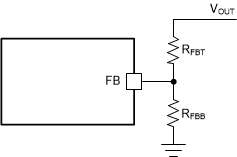ZHCSMT4C October 2021 – November 2022 LMR51420
PRODUCTION DATA
- 1 特性
- 2 应用
- 3 说明
- 4 Revision History
- 5 Device Comparison Table
- 6 Pin Configuration and Functions
- 7 Specifications
- 8 Detailed Description
- 9 Application and Implementation
- 10Device and Documentation Support
- 11Mechanical, Packaging, and Orderable Information
8.3.2 Adjustable Output Voltage
A precision 0.6-V reference voltage (VREF) is used to maintain a tightly regulated output voltage over the entire operating temperature range. The output voltage is set by a resistor divider from VOUT to the FB pin. TI recommends using 1% tolerance resistors with a low temperature coefficient for the FB divider. Select the bottom-side resistor, RFBB, for the desired divider current and use Equation 3 to calculate the top-side resistor, RFBT. The recommend range for RFBT is 10 kΩ to 100 kΩ. A lower RFBT value can be used if pre-loading is desired to reduce VOUT offset in PFM operation. Lower RFBT reduces efficiency at very light load. Less static current goes through a larger RFBT and can be more desirable when light-load efficiency is critical. However, TI does not recommend RFBT larger than 1 MΩ because it makes the feedback path more susceptible to noise. Larger RFBT values require a more carefully designed feedback path trace from the feedback resistors to the feedback pin of the device. The tolerance and temperature variation of the resistor divider network affect the output voltage regulation.
 Figure 8-2 Output Voltage Setting
Figure 8-2 Output Voltage Setting